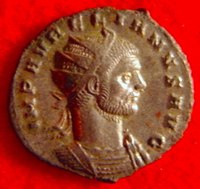This is an old revision of this page, as edited by SchreiberBike (talk | contribs) at 06:56, 11 November 2012 (You can help. Repaired link to the disambiguation page, Dacian Wars.). The present address (URL) is a permanent link to this revision, which may differ significantly from the current revision.
Revision as of 06:56, 11 November 2012 by SchreiberBike (talk | contribs) (You can help. Repaired link to the disambiguation page, Dacian Wars.)(diff) ← Previous revision | Latest revision (diff) | Newer revision → (diff)| Part of a series on the |
|---|
| History of Romania |
 |
| Prehistory |
| Antiquity |
| Middle Ages (Early) |
| Early Modern Times |
| National Awakening |
| Kingdom of Romania |
| Socialist Republic of Romania |
| Post-Revolution |
| By topic |
| By historical region |
|
|
The term Daco-Roman describes the Romanized culture of Dacia under the rule of the Roman Empire. The Romanian historian of ideas and historiographer Lucian Boia stated that the Daco-Roman formula, as an origin for the Romanian people, began to surface around 1870s.
Historical background
Before the Romans
Main articles: Dacia and Dacians See also: Getae
Arrival of the Romans
Main articles: Roman Dacia, Domitian's Dacian War, and Trajan's Dacian Wars
Post-Roman period
Language
Main articles: Eastern Romance substratum and Daco-RomanianArchaeological sites
Famous individuals
This is a list of several important Daco-Roman individuals:
- Ulpia Severina (fl. 3rd century), was a Roman Empress, Emperor Aurelian's wife whose nomen Ulpia, widespread in Dacia and other Danube provinces, suggests her origin form these regions.
See also
- The Balkan linguistic union
- Culture of Ancient Rome
- Dacian language
- Eastern Romance substratum
- Gallo-Roman
- History of Romania
- Legacy of the Roman Empire
- Origin of the Romanians
- Romance languages
- Romanian language
- Romano-British culture
Notes
- Boia 2001b, p. 92.
- Watson, Alaric (1999). Aurelian and the Third Century. London: Routledge. p. 113. ISBN 0-415-07248-4.
{{cite book}}: Cite has empty unknown parameter:|coauthors=(help)
References
- Boia, Lucian (2001b). History and Myth in Romanian Consciousness. Central European University Press}. ISBN 9789639116979.
{{cite book}}: Invalid|ref=harv(help) - Cihac, Alexandru (1870). Dictionnaire d'étymologie daco-romane: éléments latins comparés avec les autres langues romanes (in French). Frankfurt: Ludolphe St-Goar. ISBN 9780559388125.
{{cite book}}: Invalid|ref=harv(help) - Elton, Hugh (1996). Warfare in Roman Europe, AD 350-425. Oxford University Press. ISBN 978-0-19-815241-5.
{{cite book}}: Invalid|ref=harv(help)
Further reading
- Template:Ro icon Sorin Olteanu, The administrative organisation of the Balkan provinces in the 6th century AD
- Template:En icon Stelian Brezeanu: Toponymy and ethnic Realities at the Lower Danube in the 10th Century. “The deserted Cities" in Constantine Porphyrogenitus' De administrando imperio
- Template:En icon Kelley L. Ross The Vlach Connection and Further Reflections on Roman History